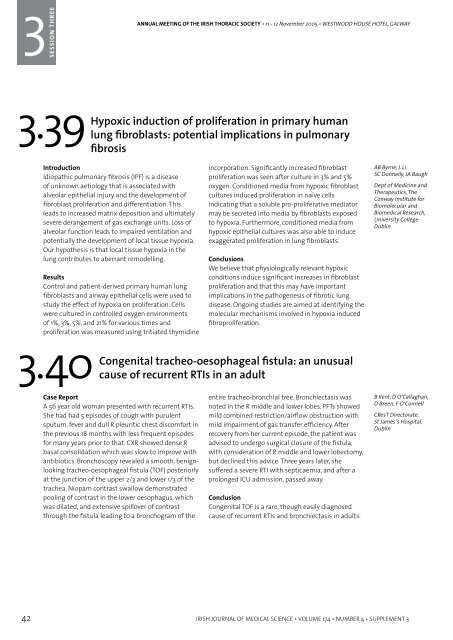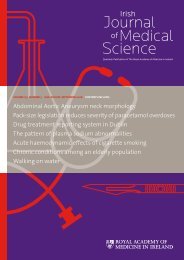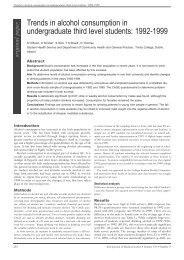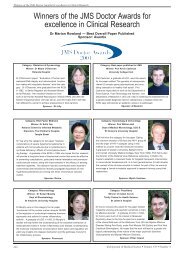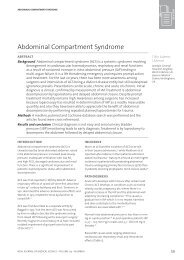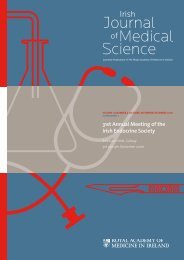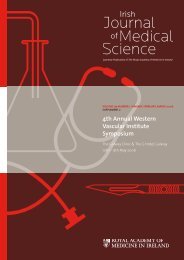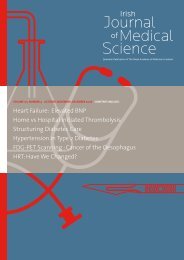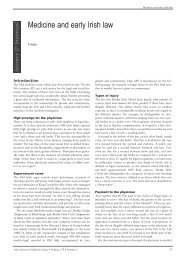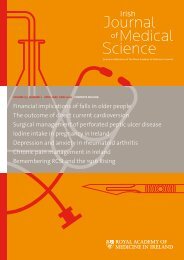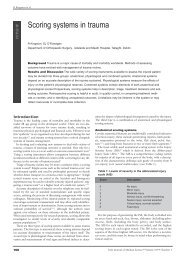Annual General Meeting of the Irish Thoracic Society - IJMS | Irish ...
Annual General Meeting of the Irish Thoracic Society - IJMS | Irish ...
Annual General Meeting of the Irish Thoracic Society - IJMS | Irish ...
You also want an ePaper? Increase the reach of your titles
YUMPU automatically turns print PDFs into web optimized ePapers that Google loves.
31<br />
1<br />
SESSION THREE ONE<br />
ANNUAL MEETING OF THE IRISH THORACIC SOCIETY • 11 - 12 November 2005 • WESTWOOD HOUSE HOTEL, GALWAY<br />
ANNUAL MEETING OF THE IRISH THORACIC SOCIETY • 11 - 12 November 2005 • WESTWOOD HOUSE HOTEL, GALWAY<br />
3<br />
SESSION<br />
SESSION THREE ONE<br />
Malignancy / Techniques<br />
3.39<br />
Hypoxic induction <strong>of</strong> proliferation in primary human<br />
lung fibroblasts: potential implications in pulmonary<br />
fibrosis<br />
Introduction<br />
Idiopathic pulmonary fibrosis (IPF) is a disease<br />
<strong>of</strong> unknown aetiology that is associated with<br />
alveolar epi<strong>the</strong>lial injury and <strong>the</strong> development <strong>of</strong><br />
fibroblast proliferation and differentiation. This<br />
leads to increased matrix deposition and ultimately<br />
severe derangement <strong>of</strong> gas exchange units. Loss <strong>of</strong><br />
alveolar function leads to impaired ventilation and<br />
potentially <strong>the</strong> development <strong>of</strong> local tissue hypoxia.<br />
Our hypo<strong>the</strong>sis is that local tissue hypoxia in <strong>the</strong><br />
lung contributes to aberrant remodelling.<br />
Results<br />
Control and patient-derived primary human lung<br />
fibroblasts and airway epi<strong>the</strong>lial cells were used to<br />
study <strong>the</strong> effect <strong>of</strong> hypoxia on proliferation. Cells<br />
were cultured in controlled oxygen environments<br />
<strong>of</strong> 1%, 3%, 5%, and 21% for various times and<br />
proliferation was measured using tritiated thymidine<br />
incorporation. Significantly increased fibroblast<br />
proliferation was seen after culture in 3% and 5%<br />
oxygen. Conditioned media from hypoxic fibroblast<br />
cultures induced proliferation in naïve cells<br />
indicating that a soluble pro-proliferative mediator<br />
may be secreted into media by fibroblasts exposed<br />
to hypoxia. Fur<strong>the</strong>rmore, conditioned media from<br />
hypoxic epi<strong>the</strong>lial cultures was also able to induce<br />
exaggerated proliferation in lung fibroblasts.<br />
Conclusions<br />
We believe that physiologically relevant hypoxic<br />
conditions induce significant increases in fibroblast<br />
proliferation and that this may have important<br />
implications in <strong>the</strong> pathogenesis <strong>of</strong> fibrotic lung<br />
disease. Ongoing studies are aimed at identifying <strong>the</strong><br />
molecular mechanisms involved in hypoxia induced<br />
fibroproliferation.<br />
AB Byrne, L Li,<br />
SC Donnelly, JA Baugh<br />
Dept <strong>of</strong> Medicine and<br />
Therapeutics, The<br />
Conway Institute for<br />
Biomolecular and<br />
Biomedical Research,<br />
University College<br />
Dublin<br />
3.41<br />
Angiosarcoma arising from <strong>the</strong> right atrium: an usual<br />
case <strong>of</strong> recurrent pulmonary embolism<br />
Introduction<br />
Angiosarcoma is an uncommon primary cardiac<br />
malignancy that usually arises from <strong>the</strong> right atrium.<br />
Clinical features are non-specific, and <strong>the</strong> tumour is<br />
frequently undiagnosed until autopsy.<br />
Method<br />
We report <strong>the</strong> case <strong>of</strong> a 37-year-old male who<br />
presented with right-sided chest pain, haemoptysis<br />
and dyspnoea.<br />
Results<br />
Pulmonary embolism was diagnosed by spiral<br />
computed tomogram (CT) scanning, however<br />
<strong>the</strong> patient failed to improve with standard<br />
anticoagulant <strong>the</strong>rapy. Repeat CT scan confirmed<br />
non-resolution <strong>of</strong> embolism and demonstrated a<br />
concomitant right atrial filling defect. Transthoracic<br />
3.42<br />
St James’ Lung Cancer Audit 2004<br />
echocardiography and magnetic resonance imaging<br />
were performed, and identified a mass lesion which<br />
extended from <strong>the</strong> free wall <strong>of</strong> <strong>the</strong> right atrium into<br />
<strong>the</strong> right main pulmonary artery. Surgical exploration<br />
confirmed extensive tumour, and radical resection<br />
was performed with right atrial reconstruction<br />
and evacuation <strong>of</strong> tumour from <strong>the</strong> pulmonary<br />
artery. Histological evaluation revealed a high-grade<br />
angiosarcoma, with positive immunohistochemial<br />
staining for CD31 and CD34. The patient was treated<br />
with adjuvant combination chemo<strong>the</strong>rapy and<br />
remains in remission at 18 months follow up.<br />
Conclusions<br />
Although <strong>the</strong> diagnosis <strong>of</strong> angiosarcoma usually<br />
portends a poor prognosis, aggressive multimodality<br />
<strong>the</strong>rapy can result in a favourable outcome.<br />
DS O’Callaghan, 1<br />
DP Breen, 1 , B Kent, 1<br />
CJ D’Adhemar, 2<br />
M Higgins, 3<br />
F O’Connell, 1 V Young 1<br />
1. CResT Directorate,<br />
2. LabMed Directorate,<br />
and<br />
3. HOPE Directorate,<br />
St James’s Hospital,<br />
Dublin<br />
3.40<br />
Congenital tracheo-oesophageal fistula: an unusual<br />
cause <strong>of</strong> recurrent RTIs in an adult<br />
Case Report<br />
A 56 year old woman presented with recurrent RTIs.<br />
She had had 5 episodes <strong>of</strong> cough with purulent<br />
sputum, fever and dull R pleuritic chest discomfort in<br />
<strong>the</strong> previous 18 months with less frequent episodes<br />
for many years prior to that. CXR showed dense R<br />
basal consolidation which was slow to improve with<br />
antibiotics. Bronchoscopy revealed a smooth, benignlooking<br />
tracheo-oesophageal fistula (TOF) posteriorly<br />
at <strong>the</strong> junction <strong>of</strong> <strong>the</strong> upper 2/3 and lower 1/3 <strong>of</strong> <strong>the</strong><br />
trachea. Niopam contrast swallow demonstrated<br />
pooling <strong>of</strong> contrast in <strong>the</strong> lower oesophagus, which<br />
was dilated, and extensive spillover <strong>of</strong> contrast<br />
through <strong>the</strong> fistula leading to a bronchogram <strong>of</strong> <strong>the</strong><br />
entire tracheo-bronchial tree. Bronchiectasis was<br />
noted in <strong>the</strong> R middle and lower lobes. PFTs showed<br />
mild combined restriction/airflow obstruction with<br />
mild impairment <strong>of</strong> gas transfer efficiency. After<br />
recovery from her current episode, <strong>the</strong> patient was<br />
advised to undergo surgical closure <strong>of</strong> <strong>the</strong> fistula,<br />
with consideration <strong>of</strong> R middle and lower lobectomy,<br />
but declined this advice. Three years later, she<br />
suffered a severe RTI with septicaemia, and after a<br />
prolonged ICU admission, passed away.<br />
Conclusion<br />
Congenital TOF is a rare, though easily diagnosed<br />
cause <strong>of</strong> recurrent RTIs and bronchiectasis in adults.<br />
B Kent, D O’Callaghan,<br />
D Breen, F O’Connell<br />
CResT Directorate,<br />
St James’s Hospital,<br />
Dublin<br />
Introduction<br />
Lung cancer remains <strong>the</strong> foremost cancer killer in<br />
Ireland, responsible for 20% <strong>of</strong> all cancer deaths.<br />
Although prevalence has fallen in men, recent years<br />
have seen a dramatic increase in lung cancer in<br />
women. Patients tend to present with late stage<br />
disease and stage for stage, lung cancer survival is<br />
worse than for o<strong>the</strong>r common cancers. Overall 5 year<br />
survival is less than 10%.<br />
Aim<br />
To audit lung cancer at St James’s for 2004.<br />
Method<br />
Interrogation <strong>of</strong> <strong>the</strong> St James’s lung cancer database.<br />
Results<br />
297 patients attended St James’s with lung cancer<br />
in 2004, representing a 6% increase on <strong>the</strong> previous<br />
year and almost 20% <strong>of</strong> <strong>the</strong> national lung cancer<br />
population. Gender analysis showed 60.9% male, 39.1%<br />
female (male:female ratio 1.56:1) with women tending<br />
to present younger than men. Almost 50% were<br />
tertiary referrals from outside <strong>the</strong> HSE SW area. 6.7%<br />
were never-smokers while 36.4% reported a family<br />
history <strong>of</strong> cancer. Analysis <strong>of</strong> morphology showed<br />
NSCLC 75%, SCLC 17.3%, Carcinoid 2%, Meso<strong>the</strong>lioma<br />
5.1% and unknown 0.7%. Of note, females represented<br />
37.6% <strong>of</strong> NSCLC (male:female ratio 1.7:1) but 45.1% <strong>of</strong><br />
SCLC (ratio 1.2:1). Stage analysis in NSCLC showed 30.4%<br />
had Stage I or II disease, 75% <strong>of</strong> whom had treatment<br />
with curative intent. 18.6% had stage III disease, 22%<br />
<strong>of</strong> whom had treatment with curative intent. 25%<br />
<strong>of</strong> those treated with curative intent for NSCLC had<br />
chemo<strong>the</strong>rapy as part <strong>of</strong> <strong>the</strong>ir treatment. Almost 50%<br />
<strong>of</strong> patients with SCLC had limited stage disease.<br />
Conclusions<br />
Lung cancer attendances at St James’s continue to<br />
rise with increasing proportion <strong>of</strong> females, who tend<br />
to present younger and have a greater propensity to<br />
develop SCLC. Chemo<strong>the</strong>rapy is playing an increasing<br />
role in treatment <strong>of</strong> NSCLC with curative intent.<br />
M Devlin, R Luddy,<br />
F O’Connell<br />
St James’s<br />
Multidisciplinary<br />
<strong>Thoracic</strong> Oncology<br />
Group<br />
42 IRISH JOURNAL OF MEDICAL SCIENCE • VOLUME 174 • NUMBER 4 • SUPPLEMENT 3<br />
IRISH JOURNAL OF MEDICAL SCIENCE • VOLUME 174 • NUMBER 4 • SUPPLEMENT 3 43


